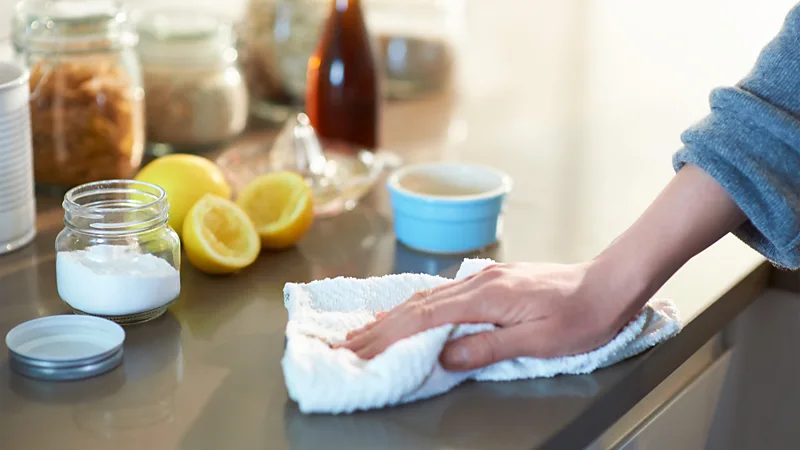Is cleaning with baking soda better for the environment?
Cleaning with baking soda is a longtime hack associated as much with old housewives as TikTok videos. But does it really work – and is it really greener way to clean?

I don't like cleaning. I also don't like buying commercial cleaning products: I worry that they are harmful both to me and to the environment. As a result, you'll sometimes find me mopping our entire kitchen floor with just kitchen roll dampened in tap water.
So when my BBC editor asked me to test a cupboard staple – baking soda – in my household chores, I agreed to give it a go. I would try a few hacks popularised online and see if they worked for me. Could they help keep my home clean, while alleviating my environmental concerns and save me money at the same time?
Keeping your home fresh by using cupboard staples like baking soda (also known as bicarbonate of soda, bicarb, sodium bicarbonate or NaHCO3, if you're feeling chemical, but not baking powder, which is a combination of baking soda and cream of tartar) is a perennial hack, associated as much with old housewives as with TikTok videos, health sites and even the Great British Bakeoff's Nancy Birtwhistle. The idea is that in certain situations, baking soda can replace shop-bought cleaning products, sparing not only the environment but also ourselves from harm.
You see all these concoctions with lemon juice, vinegar, baking soda and table salt. Most of these recipes are completely bogus – Nathan Kilah
I head to the grocery store and buy two small store-brand jars of the stuff for £0.59 ($0.77) a piece, along with a small jar of a branded version for £1.59 ($2.08). Then I call Nathan Kilah, a senior lecturer in chemistry at the University of Tasmania, Australia.
"Any cleaning property that we're going to get from baking soda arises from the chemical properties it has," he tells me. "[When we clean] there are different parts in the grime and muck that can be chemically modified by the baking soda."
Baking soda or bicarbonate of soda is a base or alkali, he explains, meaning it has a high pH. Therefore, one of its chemical properties is that it is able to remove hydrogen in the form of an ion from other materials.
"So the molecules literally react?" I ask. "It's not just that if I scrub something, I'm removing dirt?" Correct, he tells me. Although bicarbonate of soda is also a mild abrasive, meaning it can shift stubborn material off a dirty surface with the help of some elbow grease.
This is why using baking soda for limescale in the kettle would not be ideal – limescale is a base too, so the two wouldn't typically react. For that, lime or vinegar work better, because they are acidic. In fact, this seems to be the golden rule. "Acids are good for cleaning up bases," Kilah says, "whereas bases are good for cleaning up acids". (This is why the popular online trend of combining bicarbonate of soda and vinegar into a fizzy mixture for cleaning is almost completely bogus – the two substances simply cancel each other out.)
Later, I do my first cleaning experiment. I add baking soda mixed with water onto the stained fabric of a sofa cushion and leave it for 30 minutes before wiping it off. The stain is gone – but a white ring of powder has taken its place (and will, it turns out, remain for weeks). As I wipe at the substance, it feels slippery – an indication that I am dealing with alkaline matter, according to Kilah, which you can sometimes feel even when eating cakes or biscuits made using baking soda. I also try it on stained teacups with limited success. Luckily, I have another chemist to call.
"Most of the uses I see for baking soda [for cleaning] don't work," says Dario Bressanini, a chemist and science communicator from University of Insubria in Como, Italy, and author of the book The Science of Cleaning. He is puzzled about the public perception of the cupboard staple. "You see all these concoctions with lemon juice, vinegar, baking soda and table salt. Most of these recipes are completely bogus,” says Bressanini.
Its high pH, he says, is baking soda's one key power. It can be used to counteract things like bad smells in shoes, which are usually generated by organic acids produced by bacteria, and the smell of rotten tomatoes in your fridge, created by acidic liquid, but that is more or less it. And even this one power is quite weak.
I later pour a generous helping of baking soda into our bathroom sink and chase it with boiling water from the kettle. It fizzes a bit. A few bubbles form, and I feel like a wizard or a witch. But the drain remains the same. At least I didn't clog it.
Furthermore, baking soda is not a detergent – it cannot englobe dirt. Most of the dirt around us is greasy, Bressanini says. To clean that, you need surfactants, molecules which reduce the surface tension between two materials. "Soap is a surfactant. Shampoo contains surfactant and detergents contain surfactants. Baking soda does not."
Reluctant to give up, I tell Bressanini how I poured baking soda and hot water in a greasy oven tray the previous day, and the resulting goop was easily washed out. That, he explains, is because the fat and the soda reacted transforming into a stronger base. It is one way of cleaning a crusty and greasy pan. It turns out I produced soap – although actual soap, produced with the right ingredients in the right proportions, would have been better, he says.
And what about the online trend of using baking soda in your hair? Don't do it, says Bressanini. Alkaline substances raise the small plaques, or cuticles, that cover our hairs, making them weaker. That is the reason shampoos are slightly acidic, unlike soap.
Both Kilah and Bressanini assure me that cleaning with baking powder is not dangerous (so long as you don't think washing fruit in it will disinfect it, or mix different products and risk dangerous chemical reactions), but they point out strengths of supermarket cleaning products that I have not thought about before.
While cleaners from the supermarket may indeed make use of the same pH-induced chemical reaction as baking soda and vinegar, they have additional properties as well – they can break down fat, or lower the surface tension of water, or disinfect. "The thing that I'd say with a lot of these alternate baking soda cleaning methods is that they always involve scrubbing," Kilah says. "You're never just going to sprinkle it on there and walk away and expect it to be clean. You're going to scrub."
What's more, baking soda, says Bressanini, is not naturally occurring. It costs energy and resources to synthetise. It is created, I learn, from carbonate, around two thirds of which is obtained synthetically, mainly via the Solvay process (The remaining third comes from the mineral trona, which is dug out from mines). "It's produced in industrial processes that use ammonia, sodium chloride, calcium carbonate... Many of the Solvay plants around the world are huge, industrial plants," notes Bressanini.
The most important thing to do is to measure your cleaning products, and not flush unnecessary products into our seas, Bressanini says. And to use things selectively. You don't have to clean everything with bleach. My floor, I think, does not need to be as clean as my pillows.
Once created, baking soda is not in itself harmful for the environment, my experts assure me. So is cleaning with baking soda better for the environment? I ask Kilah. "On balance I would say yes," he answers. "But it depends on the comparison being made... the pathways of sourcing through manufacturing and sale are so complex."
Still, commonplace chemical cleaning products from the supermarket can be environmentally costly to produce, transport and package – and often come in volume-demanding liquid form and in more complicated packaging than baking soda, which, Kilah points out, is often stored in cardboard boxes.
These cleaners can also be harmful for humans and the environment, for example by emitting volatile organic compounds (VOC) and polyfluorinated organic compounds (Pfas) – so-called "forever chemicals", toxic compounds that can remain in humans and animals across the globe.
Powder dust blooms in my face and lands on the carpet. Afterwards, the shoes still stink. I call my experiment done
"Recent research suggests that the greatest threat to children's health from home environments across much of the industrialised world may no longer be pathogenic microbes, but impoverished microbial communities and the chemicals used in everyday products, including those for cleaning," according to research co-edited by Rachael Wakefield-Rann, a sustainability researcher at the University of Technology Sydney in Australia and author of the book Life Indoors. I call her to learn more.
We have come to define hygiene in a really narrow way, she tells me – it's become synonymous with germ avoidance. But really, many synthetic chemicals pose a great health risk; antimicrobial chemicals, for example, can be endocrine disrupting. Some microbes, on the other hand – like those on our pets – are beneficial, and even play an important role in training children's immune systems, she says.
Products that kill 99% of germs allow the nastiest ones to survive and recolonise our homes like weeds in an empty flowerbed, Wakefield-Rann says. "I think using things like vinegar, the biodiversity isn't being killed because you're not... trying to eliminate everything that's living," she explains. However, she adds, if someone has an upset stomach, for example, you may want to bring in something more intense. (Read more about why we might need less cleaning and more "targeted hygiene" in our daily lives).
Our experience, Wakefield-Rann adds, trains us to like modern cleaning products. "From a very young age, a lot of us associate pine smells or lemon smells with that kind of hospital cleanliness. [And] it's not just scent, but it's things like lather. Whether something bubbles or not is really central to whether some people judge it to be cleaning effectively," she says. The same goes for whether something's squeaky or shiny: often, Wakefield-Rann says, people seem to think natural cleaning products don't work because things don't look clean enough when they use them.
While cleaning is in some ways necessary to our lives and health, some aspects of how we view it are more cultural, says Jo Littler from the media department of Goldsmith's University in London, who together with Emma Casey, senior lecturer in sociology at the University of York, has studied online clean fluencers like Sophie Hinchcliffe, also known as Mrs Hinch. "Having a certain standard of cleanliness or cleaning in a particular way can connect you to people or give you a particular status or make you appear respectable."
Social media, Casey says, makes cleaning seem easy. "Even with the environmentally-friendly bicarbonate of soda accounts, there's quite often a very pleasing visual aesthetic, very curated. [But] cleaning with any product, let alone bicarbonate of soda, it's not easy. It's not straightforward."
I try one last baking soda hack. Grabbing a pair of smelly wellington boots, I sprinkle baking powder in them, like Bressanini recommended. Powder dust blooms in my face and lands on the carpet. Afterwards, the shoes still stink. I call my experiment done. To save the planet and my wallet, I decide, I need to gain a bigger perspective on cleanliness in general: to think of it as a grey scale rather than a black and white one. Baking soda has a place on that scale, but really, it turns out, that place is quite small.
-BBC







